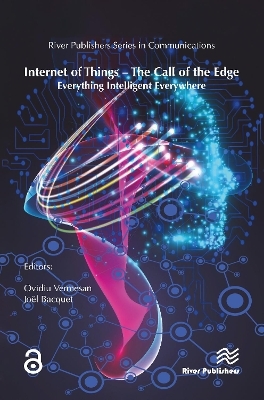
Internet of Things – The Call of the Edge
River Publishers (Verlag)
978-87-7022-196-2 (ISBN)
The book chapters build on the developments and innovative ideas put forward by the IERC, the IoT European Large-Scale Pilots Programme and the IoT European Security and Privacy Projects – presenting new concepts, ideas and future IoT trends and ways of integrating open data frameworks and IoT marketplaces into larger deployment ecosystems.
The IoT and Industrial Internet of Things technologies are moving towards hyperautomated solutions – combining hyperconnectivity, artificial intelligence (AI), distributed ledger technologies and virtual/augmented extended reality, with edge computing and deep edge processing becoming an assertive factor across industries for implementing intelligent distributed computing resources and data to keep the efficient data exchange and processing local to reduce latency, exploit the sensing/actuating capabilities and enable greater autonomy.
Expanding the adoption of consumer, business, industrial and tactile IoT requires further development of hyperautomated IoT concepts for collaborative solutions involving machines and humans to expand augmented creativity at the application level using AI to optimise the industrial processes and progress towards a symbiotic economy based on distributed federated cloud/edge infrastructure allowing resource sharing in the form of computing, memory and analytics capabilities.
The advances of autonomous IoT applications delivering services in real-time encompasses development in servitisation, robotisation, automation and hyperconnectivity, which are essential for the rapid evolution of industrial enterprises in the new digital era. The rise of digital twins integrated into IoT platforms as fully interactive elements embedded into the simulation and optimisation environment, as well as the embedment of AI techniques and methods, enhances the accuracy and performance of models in the various IoT and Industrial Internet of Things applications.
The convergence of technologies to provide scalable, interoperable IoT-enabled applications pushed the requirements for high bandwidth, low latency and robust and dependable connectivity to support the industry’s demand for deeper integration and improved analytics to deliver sustainable competitive advantage products and services, enabling digital transformation with a focus on new business models.Safety and security are interlinked for the next wave of IoT technologies and applications and combined, prove a greater value for rapid adoption.
The new IoT technologies are essential for facilitating sustainable development, reducing energy consumption and, by supporting the optimisation of products and processes, mitigating unnecessary carbon emissions – thereby reducing the environmental impact through real-time data collection, analysis, exchange, and processing.
Dr. Ovidiu Vermesan holds a PhD degree in microelectronics and a Master of International Business (MIB) degree. He is Chief Scientist at SINTEF Digital, Oslo, Norway. His research interests are in the area of mixed-signal embedded electronics and cognitive communication systems. Dr. Vermesan received SINTEF’s 2003 award for research excellence for his work on the implementation of a biometric sensor system. He is currently working on projects addressing nanoelectronics, integrated sensor/actuator systems, communication, cyber–physical systems and the IoT, with applications in green mobility, energy, autonomous systems and smart cities. He has authored or co-authored over 85 technical articles and conference papers. He is actively involved in the activities of the Electronic Components and Systems for European Leadership (ECSEL) Joint Technology Initiative (JTI). He has coordinated and managed various national, EU and other international projects related to integrated electronics. Dr. Vermesan actively participates in national, H2020 EU and other international initiatives by coordinating and managing various projects. He is the coordinator of the IoT European Research Cluster (IERC) and a member of the board of the Alliance for Internet of Things Innovation (AIOTI). Joël Bacquet is a senior official of DG CONNECT of the European Commission, taking care of the research and innovation policy for the Internet of Things. Before working in this field, he was programme officer in “Future Internet Experimental Platforms”, head of the sector “Virtual Physiological Human” in the ICT for health domain. From 1999 to 2003, he was head of the sector “networked organisations” in the eBusiness unit. He started working with the European Commission in 1993, in the Software Engineering Unit of the ESPRIT Programme. He started his carrier as visiting scientist for Quantel a LASER company in San José, California in 1981. From 1983 to 1987, he was with Thomson CSF (Thales) as software development engineer for a Radar System. From 1987 to 1991, he worked with the European Space Agency as software engineer on the European Space shuttle and international Space platform programmes (ISS). From 1991 to 1993 he was with Eurocontrol where he was Quality manager of an Air Traffic Control system. He is an engineer in computer science from Institut Supérieur d’Electronique du Nord (ISEN) and he has a MBA from Webster University, Missouri.
1 The EU IoT Policy and Regulatory Strategy – the Way Forward 3 New Waves of IoT Technologies Research – Transcending Intelligence and Senses at the Edge to Create Multi Experience Environments 4 Real-time Management of Energy Consumption in Water Resource Recovery Facilities Using IoT Technologies 5 IoT Solutions for Large Open-Air Events 6 IoT Technologies for Connected and Automated Driving Applications 7 IoT in Brazil: An Overview From the Edge Computing Perspective 8 IoT Technologies and Applications in Tourism and Travel Industries
| Erscheinungsdatum | 05.10.2020 |
|---|---|
| Verlagsort | Gistrup |
| Sprache | englisch |
| Maße | 156 x 234 mm |
| Gewicht | 671 g |
| Themenwelt | Mathematik / Informatik ► Informatik ► Theorie / Studium |
| Mathematik / Informatik ► Informatik ► Web / Internet | |
| Technik ► Nachrichtentechnik | |
| ISBN-10 | 87-7022-196-0 / 8770221960 |
| ISBN-13 | 978-87-7022-196-2 / 9788770221962 |
| Zustand | Neuware |
| Haben Sie eine Frage zum Produkt? |
aus dem Bereich


